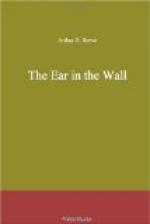“People generally, who have not investigated the subject,” he remarked as he worked, “hold the opinion that the typewriter has no individuality. Fortunately that is not true. The typewriting machine does not always afford an effective protection to the criminal. On the contrary, the typewriting may be a direct means of tracing a document to its source and showing it to be what it really is. This is especially true of typewritten anonymous letters. Without careful investigation it is impossible to say what can be determined from the examination of any particular piece of typewriting, but typewriting can often be positively identified as being the work of a certain particular typewriting machine and even the date of writing can sometimes be found out.”
He had been carefully counting something under the lens of a pocket glass. “Even the number of threads to the inch in the ribbon, as shown in the type impression, plainly seen and accurately measured by the microscope or in an enlarged photograph, may show something about the identity of a disputed writing.”
He was pointing to a letter “r.” Under the glass I noticed that there was a break in the little curl at the top.
“Now if you find such a break in the same letter in another piece of typewriting, what would you think?”
“That they were from the same machine,” I replied.
“Not so fast,” he cautioned. “True, it might raise a presumption that it was from the same machine. But the laws of chance would be against your enthusiasm, Walter.”
“Of course,” I admitted on second thought.
“It’s just like the finger-print theory. There must be a sort of summation of individual characteristics. Now here’s a broken ‘l’ and there is an ‘a’ that is twisted. Now, if the same defects are found in another piece of writing, that makes the presumption all the stronger, and when you have massed together a number of such characteristics it raises the presumption to a mathematical certainty, does it not?”
I nodded and he went on. “The faces of many letters inevitably become broken, worn, or battered. Not only does that tend to identify a particular machine, but it is sometimes possible, if you have certain admitted standard specimens of writing covering a long period, to tell just when a disputed writing was made. There are two steps in such an inquiry, the first the determination of the fact that a document was written on a certain particular kind of machine and the second that it was written on a certain individual machine of that make. I have here specimens of the writing of all the leading machines. It is easy to pick out the make used, say in the ‘Outcast’ letter. Moreover, as I said when I first saw that letter, it is in the regular pica type. So are they all, but as ninety-five per cent, use the pica style that in itself proved nothing.”
“What is that bit of ruled glass?” asked Clare, bending over the letters in deep interest.




